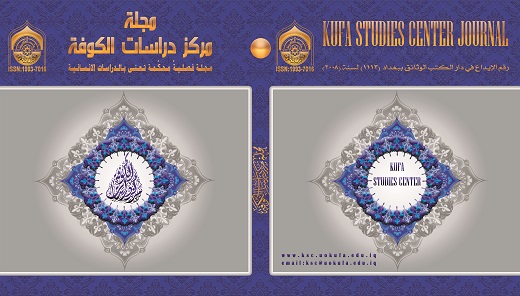التناص القرآني في أشعار أديب كمال الدين
DOI:
https://doi.org/10.36322/jksc.v1i47.5080Abstract
سار في الآونة الأخير النقد الأدبي مسارات عدّة و تشعب بتشعبات عديدة منها نظرية التناص حيث لها أصول في نقدنا القديم في قضايا الاِقتباس والتضمين والسرقات الشعرية؛ لکن نظرية التناص التي طرحتها جوليا کريستيفا هي نظرية جديدة و تعني تداخل النصوص و بصورة هادفة و لغرض معيّن. التناص في حدّ ذاته تنوّع بأنواع متعددة و منها التناص القرآني الذي يندرج تحت إطار أکبر وهو التناص الديني، في بحثنا هذا درسنا التناص القرآني في أشعار أديب کمال الدين و درسنا الأشعار التي تناصّ معها الشاعر أو استخدم القصص القرآنية وذکرنا اسباب تناصه منها نفسيته و منها عطفه علی البشرية کافة التی أوجبت استخدامه للتناص و ذلک باستخدام التناص الذاتي لکن معنی هذا أنّه لا ينسی التناص الظاهري ولا يغفل استخدام الإيقاع القرآني الموجود في القرآن الکريم ولاسيما في سورة الرحمن التي تناصّ معها و من ضمن النتائج يمکن الإشارة إلی استخدم عنصر الغياب في تناصه القرآني و أراد من الغياب عنصر الغربة، غربة يوسف(ع) و إخوته؛ و غربة أديب کمال الدين و باقي أبناء الرافدين.
Contemporary literary criticism has created various trends and has been divided into various categories, namely the theory of intertextuality which stems from techniques such as adoption and Tazmin (a form of allusion in Iranian and Arabic literary culture) in classical literature. However, the theory of intertextuality, which was proposed by Julia Kristeva, is a new theory which deals with deliberate interrelatedness between the texts. Intertextuality is divided into various types such as Quranic intertextuality which itself is a subset of religious intertextuality. In the present research, we will investigate Quranic intertextuality in the poetry of Adib Kamal al-Din. We have investigated the verses and stories of Quran employed by Adib Kamal al-Din in his poetry; and the reason behind their usage including his personality and his attempt for expressing the difficulties that people were subjected to, have been elaborated; this brings us to intrinsic or internal intertextually, yet it does not mean that formal intertextuality and the music of Quran have been ignore; quite on the contrary, formal intertextuality, specially in the Sura of Al-Rahman, has been concentrated on. Among the achievements, the element of “disappearing” which relates to roving and alienation as observed in the story of Joseph and his brothers and Adib Kamal al-din and his compatriots is worth mentioning.
Downloads
Downloads
Published
How to Cite
Issue
Section
License
Copyright (c) 2022 مجلة مركز دراسات الكوفة | Journal of Kufa Studies Center

This work is licensed under a Creative Commons Attribution 4.0 International License.
Permit others to distribute and copy the manuscript, to create extracts, abstracts, and other revised versions, adaptations, or derivative works of or from the manuscript (such as a translation), to include in a collective work, to text or data mine the article, even for commercial purposes, as long as they credit the author(s), do not represent the author as endorsing their adaptation of the article, and do not modify the article in such a way as to damage the author''''s honor or reputation. Further details are found at Creative Commons Attribution 4.0 International (CC BY 4.0)






























